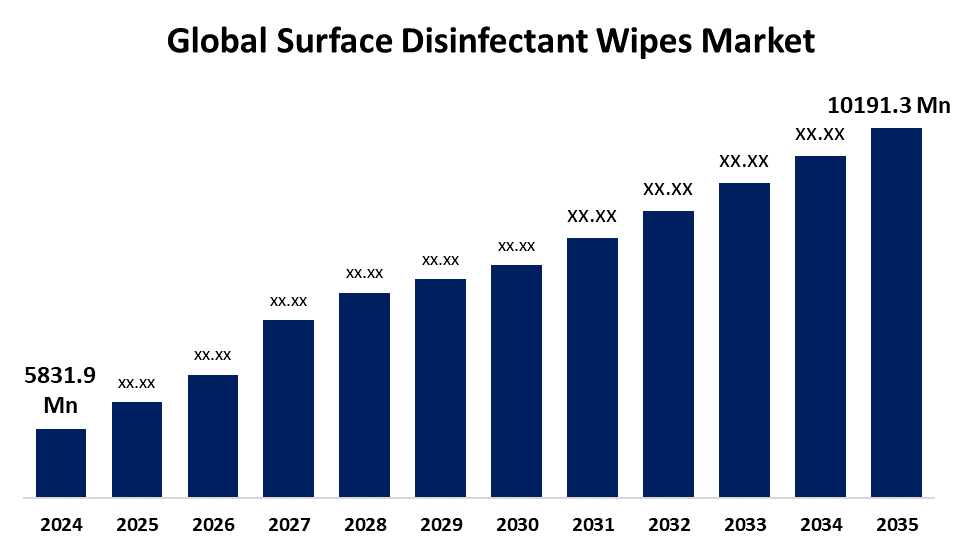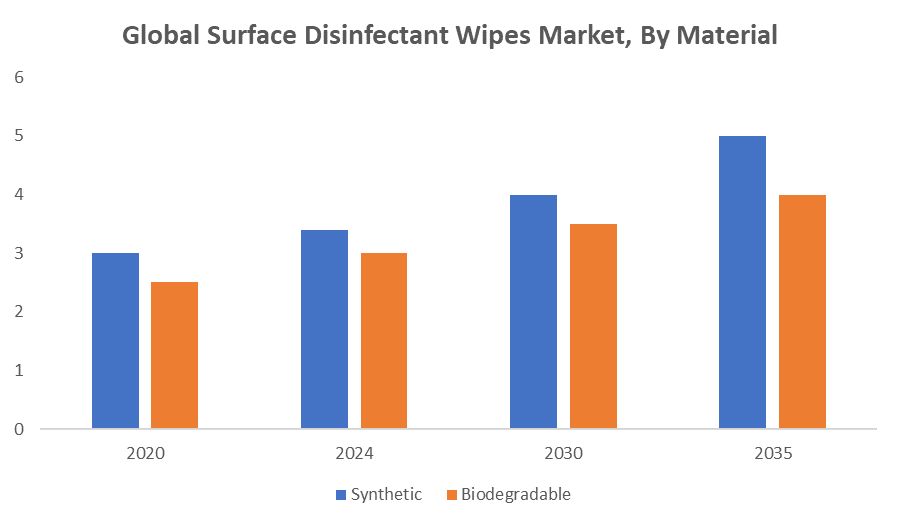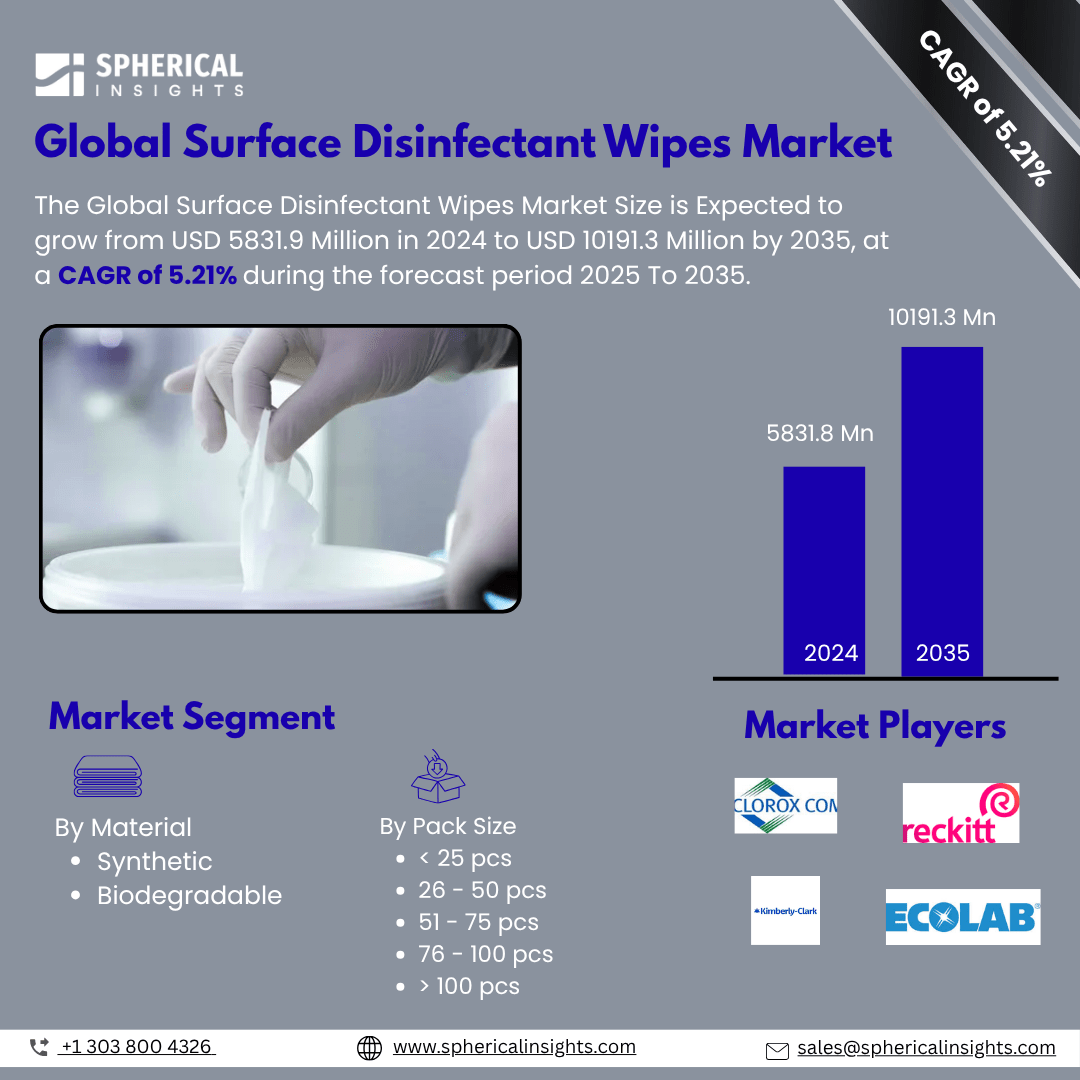Global Surface Disinfectant Wipes Market Insights Forecasts to 2035
- The Global Surface Disinfectant Wipes Market Size Was Estimated at USD 5831.9 Million in 2024
- The Market Size is Expected to Grow at a CAGR of around 5.21% from 2025 to 2035
- The Worldwide Surface Disinfectant Wipes Market Size is Expected to Reach USD 10191.3 Million by 2035
- Central & South America is Expected to Grow the fastest during the forecast period.

Surface Disinfectant Wipes Market
The global surface disinfectant wipes market involves the manufacturing and distribution of pre moistened wipes designed to sanitize various surfaces by removing harmful bacteria, viruses, and other pathogens. These wipes are widely utilized across healthcare, commercial, and residential settings to ensure cleanliness and reduce the risk of infection transmission. Products in this market vary by material composition, including synthetic and biodegradable fibers, and by active disinfectant agents such as alcohol, quaternary ammonium compounds, and hydrogen peroxide. The market has seen steady growth due to increasing demand for convenient and effective cleaning solutions. Leading companies in this sector include Clorox, Reckitt Benckiser, and Ecolab, which continuously innovate to improve efficacy and sustainability. As consumer awareness around hygiene continues to rise, surface disinfectant wipes are becoming an essential item for everyday use, driving ongoing product development and diversification within the market. Overall, this market represents a critical segment in the broader hygiene and cleaning industry.
Attractive Opportunities in the Surface Disinfectant Wipes Market
- Rising consumer demand for sustainable hygiene products offers companies the chance to develop and market biodegradable and eco-friendly wipes, catering to environmentally conscious buyers.
- Surface disinfectant wipes are increasingly being used in emerging sectors such as automotive, electronics, and food service industries, opening up new avenues for market growth and product diversification.
- Advancements in wipe formulations and materials improve effectiveness, durability, and shelf life, creating opportunities for companies to differentiate their products and meet evolving consumer needs.
- The rise of online shopping platforms makes surface disinfectant wipes more accessible globally, particularly in developing countries where improving healthcare infrastructure and urbanization drive demand.
Global Surface Disinfectant Wipes Market Dynamics
DRIVER: Increasing awareness of hygiene and infection control
The global surface disinfectant wipes market is driven by several key factors. Increasing awareness of hygiene and infection control, especially following the COVID-19 pandemic, has significantly boosted demand for these wipes across healthcare, commercial, and residential sectors. Consumers and organizations prioritize effective surface cleaning to prevent the spread of viruses and bacteria, elevating the use of disinfectant wipes as a convenient and efficient solution. Additionally, rising health and safety regulations worldwide encourage regular disinfection practices, further propelling market growth. The wipes’ ease of use, portability, and quick action make them highly popular among consumers seeking hassle-free sanitation options. Moreover, innovations in product formulations, such as the development of eco-friendly and biodegradable wipes, cater to the growing demand for sustainable hygiene products. These advancements, combined with expanding distribution channels like e commerce, have increased product accessibility, further fueling market expansion. Overall, growing health consciousness and technological innovation remain key drivers of this market’s upward trajectory.
RESTRAINT: Environmental impact of single-use
The global surface disinfectant wipes market faces several restraints that could impact its growth. One major concern is the environmental impact of single-use, non-biodegradable wipes, which contribute to plastic waste and landfill accumulation. This has led to increased regulatory pressure and growing consumer demand for eco-friendly alternatives, such as biodegradable wipes, which tend to have higher production costs. Additionally, fluctuations in raw material prices, including key ingredients like isopropyl alcohol and synthetic fibers, create challenges in maintaining stable manufacturing costs. Supply chain disruptions, such as delays in raw material procurement and packaging shortages, further complicate production and distribution processes. The market also faces strong competition from alternative cleaning products like disinfectant sprays, which are often perceived as more cost-effective and environmentally friendly. These factors collectively act as restraints, potentially slowing market growth and affecting profitability for manufacturers and suppliers in the surface disinfectant wipes industry.
OPPORTUNITY: Growing interest in eco friendly and biodegradable wipes
The surface disinfectant wipes market has many new opportunities for growth. There is a growing interest in eco-friendly and biodegradable wipes, which gives companies a chance to create products that are better for the environment. These wipes are also being used in new areas like cars, electronics, and food service, which opens up more ways to sell them. New technology is helping make wipes that work better and last longer on different surfaces. Online shopping is making it easier for people to buy these wipes from anywhere. Also, in developing countries, as healthcare improves and cities grow, more people will need these products. Working with government groups to make sure wipes are safe and effective can help more people trust and use them. These opportunities help the market grow and offer better products to customers.
CHALLENGES: Consumer skepticism regarding the effectiveness of disinfectant wipes compared to other cleaning methods
One major challenge is consumer skepticism regarding the effectiveness of disinfectant wipes compared to other cleaning methods, which can limit widespread adoption. Additionally, frequent changes in regulations and safety standards across different countries create compliance complexities for manufacturers, increasing costs and delaying product launches. The development of antimicrobial resistance is another concern, as overuse of disinfectants might reduce their long term effectiveness. Furthermore, intense competition from numerous brands leads to price wars, reducing profit margins for companies. Packaging waste and disposal issues also pose challenges, as improper disposal can harm the environment and affect brand reputation. Lastly, educating consumers on the correct usage and disposal of wipes remains a hurdle, as misuse can result in reduced effectiveness and environmental damage. These challenges require strategic planning and innovation to ensure sustainable market growth.
Global Surface Disinfectant Wipes Market Ecosystem Analysis
The global surface disinfectant wipes market ecosystem includes raw material suppliers providing fabrics and disinfectants, manufacturers like Clorox and Reckitt Benckiser producing various wipes, and distribution channels such as retail stores and online platforms. Regulatory bodies ensure product safety and compliance, while end users span healthcare, commercial, and residential sectors. Supporting services like marketing, research, and sustainability consultants help drive innovation and consumer awareness. Together, these interconnected players promote product development, accessibility, and responsible use in the surface disinfectant wipes market.
Based on the material, the synthetic surface disinfectant wipes accounted for a revenue share during the forecast period

Synthetic surface disinfectant wipes accounted for a significant revenue share during the forecast period. Their durability, effectiveness in holding disinfectant solutions, and cost-efficiency make them a preferred choice across healthcare, commercial, and residential sectors. Synthetic wipes also offer versatility in formulations, allowing manufacturers to incorporate various disinfectant agents. This combination of performance and affordability has contributed to their strong market presence and steady revenue contribution throughout the forecast period.
Based on the pack size, the 51 75 pcs held a significant revenue share and are expected to grow at a significant CAGR during the forecast period

The 51 75 pieces pack size of surface disinfectant wipes holds a significant revenue share due to its ideal balance of convenience and value. It provides enough wipes for multiple uses, making it cost effective for both individual consumers and businesses such as healthcare facilities, offices, and hospitality sectors. This pack size is compact and easy to store, appealing to users who want an efficient and portable disinfection solution without the bulk of larger packs. Its practicality and affordability drive strong demand, supporting its expected growth at a notable CAGR during the forecast period.
North America is anticipated to hold the largest market share of the surface disinfectant wipes market during the forecast period
North America is anticipated to hold the largest market share in the surface disinfectant wipes market during the forecast period. This dominance is driven by high consumer awareness about hygiene, stringent government regulations on sanitation, and widespread adoption of disinfectant products across healthcare, commercial, and residential sectors. The region’s well established healthcare infrastructure and strong presence of key market players further contribute to its leading position. Additionally, growing demand for convenient and effective cleaning solutions among consumers supports steady market growth in North America throughout the forecast period.
Central & South America is expected to grow at the fastest CAGR in the surface disinfectant wipes market during the forecast period
Central & South America is expected to grow at the fastest CAGR in the surface disinfectant wipes market during the forecast period. This rapid growth is driven by increasing awareness of hygiene and sanitation, improving healthcare infrastructure, and rising urbanization in the region. Additionally, expanding distribution networks and growing consumer preference for convenient cleaning solutions contribute to market expansion. As more industries and households adopt disinfectant wipes, the demand is set to rise significantly, positioning Central & South America as a key emerging market in this sector.
Recent Development
- In August 2024, Clorox introduced Clorox EcoClean Disinfecting Wipes, made with 100% plant-based substrates and naturally derived ingredients, aligning with the growing demand for eco friendly cleaning products.
- In July 2024, Ecolab launched disinfectant wipes derived from wood pulp fibers, offering a 100% plastic free option with a two-year shelf life, effective against over 40 microorganisms, including SARS CoV 2.
Key Market Players
KEY PLAYERS IN THE SURFACE DISINFECTANT WIPES MARKET INCLUDE
- Clorox Company
- Reckitt Benckiser Group PLC
- Ecolab Inc.
- 3M Company
- Kimberly Clark Corporation
- Procter & Gamble Co.
- S. C. Johnson Professional
- GOJO Industries, Inc.
- Metrex Research, LLC
- PDI Healthcare
Market Segment
This study forecasts revenue at global, regional, and country levels from 2020 to 2035. Spherical Insights has segmented the surface disinfectant wipes market based on the below mentioned segments:
Global Surface Disinfectant Wipes Market, By Material
Global Surface Disinfectant Wipes Market, By Pack Size
- < 25 pcs
- 26 50 pcs
- 51 -75 pcs
- 76 100 pcs
- > 100 pcs
Global Surface Disinfectant Wipes Market, By Regional Analysis
- North America
- Europe
- Germany
- UK
- France
- Italy
- Spain
- Russia
- Rest of Europe
- Asia Pacific
- China
- Japan
- India
- South Korea
- Australia
- Rest of Asia Pacific
- South America
- Brazil
- Argentina
- Rest of South America
- Middle East & Africa
- UAE
- Saudi Arabia
- Qatar
- South Africa
- Rest of the Middle East & Africa






